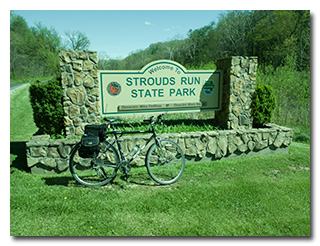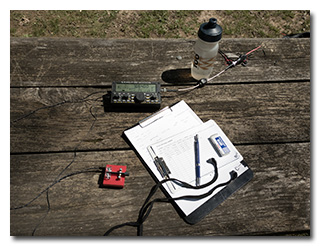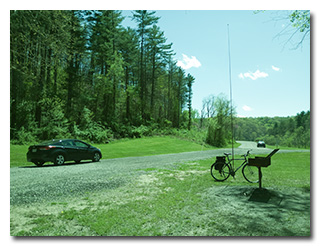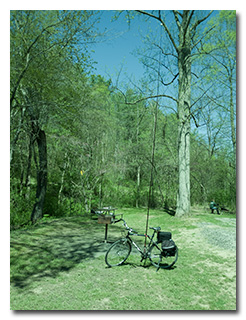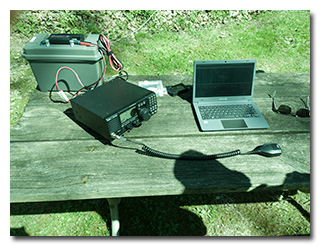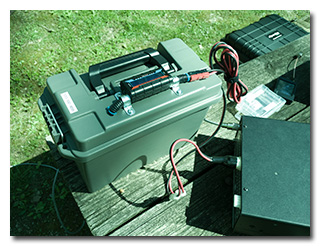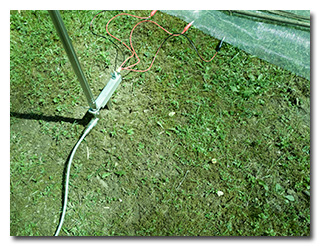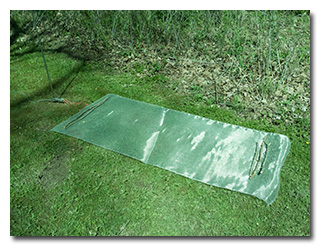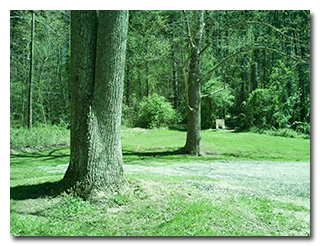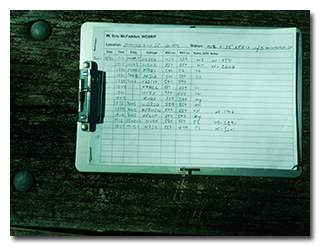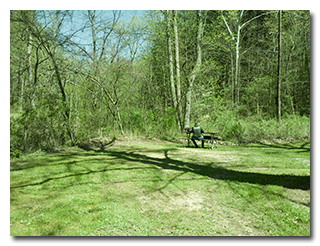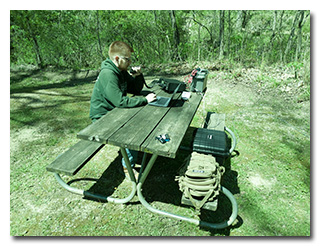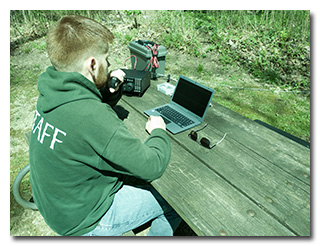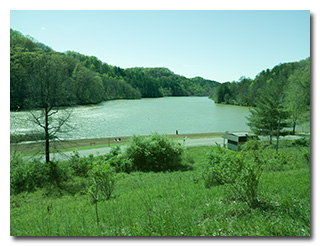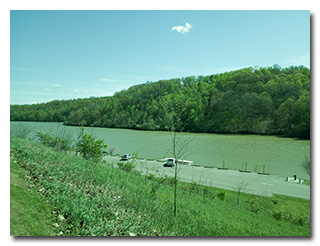
by William Eric McFadden
From the Strouds Run State Park website:
-
The park derives its name from the Strouds family who settled in the area in the early 1800s. The land was purchased by the state for forest conservation purposes from 1948 to 1953. The dam creating Dow Lake was completed in 1960. The lake bears the name of C.L. Dow of Ohio University who was instrumental in initiating the project.
Pictures
- The Strouds Run State Park sign
- Eric's KX2 station
- Eric's mast and antenna: 1 | 2
- Josh's IC-718 station and his battery box
- Josh's Wolf River Coils 213" whip and mounting-spike and Josh's window-screen counterpoise
- Josh operating: 1 | 2 | 3
- The view from Eric's picnic table
- Eric's log
- Dow Lake: 1 | 2
Description
On Saturday, April 20, 2024, one member of the Southeast Ohio Radio Adventure Team performed a successful bicycle-portable activation of Strouds Run State Park (US-1994) as part of the Parks on the Air (POTA; link) program while participating in the annual QRP to the Field (link) field event.
Eric McFadden, WD8RIF, visited Strouds Run State Park to participate in QRP to the Field and to perform his 100th activation of the park to complete his quest to earn the Eagle's Nest Repeat Offender Activator Award for 100 activations of the park. He was met at the park by Josh Senefeld, N8VXR, (blog) who was to perform his 10th activation of the park.
Despite seriously gusty winds and a temperature only around 60°, Eric thought it would be appropriate to perform this 100th activation of the park as a bicycle-portable operation. Because of the wind, however, he compromised and started his ride at his office on the Ohio University campus instead of at his home, in order to shorten the ride and to remove some of the steep hills. Eric began his ride at about 1730 UTC but forgot to record his ride on Strava. His bicycle's odometer indicated the ride to be about six miles in length, and he arrived at Strouds Run State Park's swim-beach area at 1800 UTC.
Josh, who was carrying significantly heavier gear than Eric was carrying, used his automobile to get the park and, arriving a few minutes earlier than Eric, scoped out possible operating locations and selected the picnic area at the entrance to the swim-beach area on Strouds Run Road.
Eric chose one of the two picnic tables at the site for his operating location, set up his Elecraft KX2, erected his Goture Red Fox Super Hard 720 carbon-fiber mast on his bicycle (hoping that the gusty winds wouldn't blow it down), sloped his Tufteln (link) 35' EFRW antenna from the KX2 up to top of the mast, and deployed three 17' counterpoise wires directly on the ground. Eric was on the air at 1812 UTC.
Josh's station consisted of an ICOM IC-718 (with a non-functional display due to a recent accident at Lake Logan State Park; a new display is enroute from Taiwain), a Wolf River Coils 213" telescoping whip, and window-screen material deployed as a Faraday screen counterpoise. Josh was also on the air about 1812 UTC.
With solar numbers indicating poor HF propagation, Eric and Josh both anticipated the need to spend considerable time to get the ten QSOs required for a valid POTA activation.
As expected, Eric found he had good cell-signal at this location and he would be able to spot himself on the POTA Spots website (link) and to use POTA Spots to identify possible Park-to-Park (P2P) QSOs.
Eric started his operation on 20m, unaware at the time that Josh had already started hunting for P2P QSOs on the band, forcing Josh to switch to 17m. Eric first tuned around to look for stations calling "CQ TTF" for QRP to the Field but heard none. However, he did find a station calling "CQ POTA" and at 1813 UTC he succeeded in completing a QSO with NE2CZ who was performing a two-fer activation of Wawayanda State Park (US-1636) and Abram S. Hewitt State Forest (US-4991) in New Jersey. After checking POTA Spots for other P2P QSO opportunities, at 1815 UTC Eric worked W2NR who was activating Silver Lake State Park (US-2678) in New Hampshire.
Finding his own frequency to run on 20m, Eric began calling "CQ POTA" and was auto-spotted on POTA Spots. Many minutes of calling CQ resulted in only one additional QSO, at 1821 UTC with K9QY in Illinois. During this rather unsuccessful run, it became apparent that Josh's 50w SSB on 17m was causing serious noise in Eric's receiver and this noise might well have been masking calls from weak stations.
Hoping for better success on 15m, Eric switched to that band and began calling "CQ POTA" but was overwhelmed by QRM from Josh's station.
Switching to 40m, Eric was pleased that on this band Josh's signal wasn't creating nearly as much noise; Eric could hear an increase in noise as Josh transmitted, but he felt he could work through it. Finding himself a clear frequency to run, Eric began calling "CQ POTA" and self-spotted himself on POTA Spots. Eric's first QSO in this run was a P2P QSO at 1832 UTC with AC3IE at PA 332 State Game Land (US-11247) in Pennsylvania and his second came at 1838 UTC with KB3CVO in Pennsylvania.
At this point, the QRM from Josh's 50w SSB signal, perhaps because Josh was now on 20m, was getting difficult to work around, and Eric paused his operation in to do some photography to watch Josh make SSB QSOs. Eric returned to his rig about ten minutes later to try again. Despite the QRM, Eric managed to make four more QSOs on 40m between 1848 UTC and 1853 UTC: N9DGL in Indiana, WX9X in Indiana, KN2X in New York, and WB8DD in Ohio.
Pausing to hunt for P2P QSOs, at 1859 UTC Eric managed to complete a P2P QSO on 40m with KE8NJW who was activating Delaware State Park (US-1946) in Ohio.
Resuming his run on 40m, Eric managed to make just one more QSO on that band, at 1906 UTC, with KF2HP in Kentucky.
Eric finished his activation by hunting for P2P QSOs. At 1913 UTC he completed a P2P QSO on 17m with NV4H who was activating Fred C. Babcock / Cecil M. Webb Wildlife Management Area (US-6291) in Florida. At 1925 UTC, after Josh shut down his station and had come over to look at Eric's station, Eric completed a P2P QSO on 20m with NS1C who was activating Okeechobee Battlefield State Park (US-3641).
In all, Eric logged thirteen QSOs, with seven P2P QSOs, in just about an hour and thirteen minutes. All of Eric's QSOs were CW and were made at five watts output.
For QRP to the Field, Eric had four eligible QSOs on 20m, with three P2P QSOs counting as "Field", and four SPCs. On 40m, he had eight eligible QSOs, with one P2P QSO counting as "Field", and five SPCs. With himself being "Field", Eric's calculated score was 219. Since he had not called "CQ TTF" and hadn't sent the full QRP to the Field exchange, Eric included a note with his submission to Paul, NA5N, that his log might need to be considered a "check log".
Josh completed twenty QSOs, ten of which were P2P, and he reported he wasn't bothered much by QRM from Eric's flea-power rig. Josh has published a report about his activation and it's available on his blog (link).
For his bicycle ride back to his car, Eric did remember to start recording on Strava, and he included in his ride the loop past the swim-beach and up the hill in order to look down upon Dow Lake.
Eric also submitted his log to the World Wide Flora and Fauna in Amateur Radio (WWFF; link) program for an operation at Strouds Run State Park, KFF-1994.
(return)
